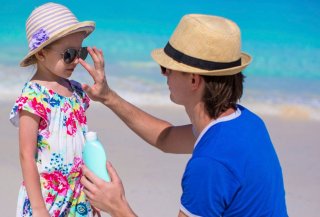Ultraviolet (UV) Radiation and Sun Exposure
- Too much ultraviolet radiation (UV) from sunlight is dangerous.
- Nearly half of UV radiation is received between 10 a.m. and 4 p.m., when the sun’s rays are the strongest.
- Even on a cloudy day, you can be sunburned by UV radiation.
We’ve all heard the phrase, “a healthy tan,” but there is no such thing. Tanning is your body's attempt to protect itself from being damaged by ultraviolet (UV) radiation.
About Ultraviolet (UV) Radiation and Sun Exposure
The sun sends energy to Earth in a few different ways: visible light that you can see, infrared radiation that you feel as heat, and rays of UV radiation that you can’t see or feel. Fortunately, the Earth’s atmosphere protects us from most UV radiation. While we need some exposure to sunlight to help our bodies make vitamin D, too much UV is dangerous.
Source: U.S. Centers for Disease Control and Prevention (CDC)
There are three types of UV rays:
Ultraviolet A rays (UVA)
- The atmosphere does little to shield these rays—most UVA radiation reaches Earth’s surface.
- UVA rays cause skin aging and eye damage, and can lower your body’s ability to fight off illness. UVA rays also contribute to the risk of skin cancer.
Ultraviolet B rays (UVB)
- The Earth’s atmosphere shields us from most UVB rays—the amount of UVB rays that reach the Earth’s surface depends on latitude, altitude, time of year and other factors.
- UVB rays cause sunburns, skin cancer, skin aging, and snow blindness (a sunburn to your cornea that causes a temporary loss of vision) and can lower your body’s ability to fight illness.
Ultraviolet C rays (UVC)
- UVC rays do not reach the Earth’s surface because they are completely absorbed by the atmosphere.
- Harmful effects from UVC rays are minimal.
The UV radiation that reaches the Earth’s surface is mostly UVA and some UVB. Almost half the daytime total of the more harmful UVB radiation is received between the hours of 10 a.m. and 4 p.m. Even on a cloudy day, you can be sunburned by UVB radiation.
Skin cancer is the most common form of cancer in the United States. While everyone should protect themselves against UV radiation, it is particularly important to protect children. Most of an average person's UV exposure from the sun occurs before the age of 18. Too much UV exposure or frequent sunburns, particularly during childhood, can make developing skin cancer more likely.
What You Can Do
- Limit time in the midday sun. The sun's rays are strongest between 10 a.m. and 4 p.m. Limit exposure to the sun during these hours, even in winter and especially at higher altitudes.
- Do not burn. Sunburns significantly increase the lifetime risk of developing skin cancer, especially for children.
- Seek shade. Shade is a good source of protection. However, keep in mind that trees, umbrellas and canopies do not offer complete sun protection.
- Use extra caution near water, snow and sand. These three materials reflect the damaging rays of the sun, which can increase your chance of sunburn.
- Avoid sun tanning and tanning beds. UV light from tanning beds and the sun can cause skin cancer and wrinkling.
- Wear protective clothing. Wide brimmed hats offer good sun protection for your eyes, ears, face and neck. Sunglasses that provide 99 to 100% UVA and UVB protection will greatly reduce eye damage from sun exposure. Tightly woven, loose fitting clothes will provide additional protection from the sun.
- Always use sunscreen. Apply a broad-spectrum sunscreen with a SPF of 30 or higher on all exposed skin 20 minutes before going outside. Reapply every two hours, or after working, swimming, playing or exercising outdoors.
- Watch the UV Index. The UV Index provides important sun safety information to help people plan outdoor activities.
Regardless of your exposure to UV rays, conduct a monthly self-check to look for any skin abnormalities. Have a friend or family member check your back and scalp. Look for bumps or sores that don't heal or for moles that have changed size, color or shape. It’s important to visit your physician or a dermatologist for regular skin checks and to have any new or changing mole evaluated. When caught early, most cases of skin cancer can be cured.

